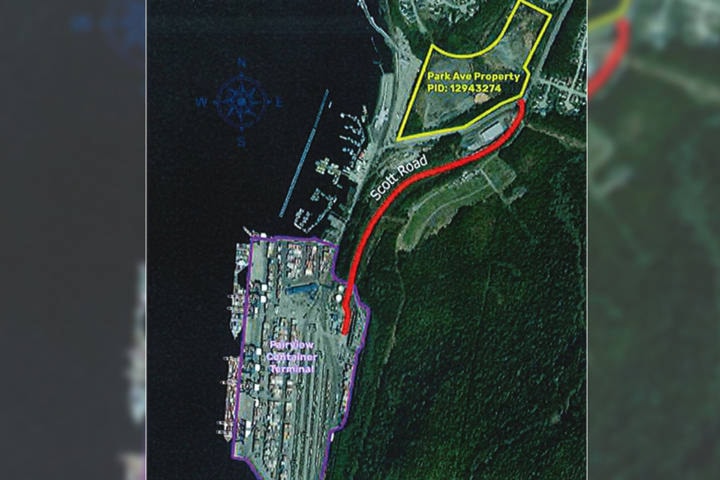The Prince Rupert Port Authority (PRPA) is examining its options after city council rejected a permit application to store overflow shipping containers in a vacant lot next to the Scott Road and Hwy 16 intersection.
The 12-hectare site is currently mixed zoning of R1 residential and P1 public use. Council declined a two-year Temporary Use Permit (TUP) due to lack of details in the application and resident concerns mostly over noise.
Staff also advised council against the move due to the two-year TUP exceeding the limit of six months. In addition, TUPs are not permitted on properties zoned for residential use. The port requested a variance from that provision, noting the site’s original zoning was intended for light industrial use but rezoned residential for a now defunct development project.
Due to current market conditions, the PRPA said a higher volume of empty containers is impeding operations during the Fairview Terminal expansion.
The current property owner is using a portion of the land as a fill site, which made it ideal for light industrial development. The port intended to lease the land for two years with the option to later purchase and formalize the property as a buffer between the industrial activity at Fairview Terminal and the residential neighbourhoods, with the expectation there will be demand for activities such as longshore training, servicing of equipment and warehousing.
Ken Veldman, PRPA vice president of public affairs and sustainability, said he appreciates residents’ concerns with noise generated in the short term from container storage, but added the long-term plan for the site would be complimentary to the community.
“If we were to purchase that property and develop it as a whole, as a federal land manager we would be subject to all the federal regulations … but at this point we had just entered this conditional lease agreement and one of the conditions obviously was to see if we could pave the way for temporary use,” Veldman said.
“In the long term, the OCP [City of Prince Rupert Official Community Plan] actually designates most of that land as light industrial, so it seemed like a pretty copacetic land use that we felt the temporary permit fit within the spirit of quite well.
Veldman couldn’t say for certain if heavier activities like container storage would continue if the purchase went through.
Council heard from two resident delegations opposed to the TUP, one of whom submitted a petition of more than 100 signatures from other community members concerned about noise, lights, diesel activity and a 24-hour work schedule.
Resident Bruce Hansen pointed out the potential for negative impacts on a salmon-bearing creek running through the site.
“I find it very surprising and alarming that none of the correspondence with regards to this bylaw change mentions the impact to any spawning habitat,” he said.
Hansen served as a project manager for the community fisheries development centre in 1999 on a salmon habitat restoration project on Moresby creek with a letter of agreement from the City of Prince Rupert. The project was a joint venture between the city, the former property and Fishery Renewals BC who contributed more than $200,000 for construction of a fish ladder and wetlands remediation, Hansen said.
He told council there were several studies now confirming spawning habitat for salmon and trout as a result of the project.
He stressed the restoration project wasn’t meant to restrict development, but improve livability of the city through a communal effort to balance the health of the habitat with residential neighbourhoods. He urged council to reject any rezoning that will push that effort further out of reach.
“For a city that is trying to find some new residential properties to build on, I find it quite difficult to believe they would turn an existing residential property into an industrial area and completely disrupt the existing surrounding residential areas.”
Rejecting the TUP application, council advised PRPA to submit a full rezoning application with a detailed site plan, the process for which would be faster than having to rewrite existing TUP bylaws.
Veldman said the port was fully aware of the salmon-bearing creek, which would be considered in any development plans. Environmental rehabilitation and recreational development of the Moresby Creek Trail were possibilities if the land purchase was successful in the long term.
PRPA is now considering several short-term storage options, but is not yet committing to a full rezoning application.
